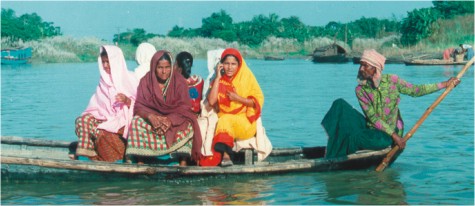 |
|
 |
|
 |
 |
|
 |
|
 |
|
 |
|
 |
|
Micro-credit is an authentic Bangladeshi innovation that has revolutionised the world. Lamiya Morshed shines a light on this pioneering financial institution that has changed the face of poverty in Bangladesh and transformed thinking about the potential and capacity of the poor the world over.
The micro-credit miracle
Grameen Bank was initiated in 1976 by Professor Muhammad Yunus as an action research project of Chittagong University. In a village near the university called Jobra, he found that the poor did not have access to small amounts of capital to engage or build on their tiny livelihood activities. The only source of capital were loans from money- lenders at exorbitant rates of interest. As an experiment, he began a project to provide small loans to poor women in Jobra to engage in income generating activities. In all cases, the poor women took loans from the project, invested their money, and generated enough income to pay back their loans and keep a profit.
This experience in Jobra challenged the conventional wisdom that the poor were not bankable. Critics believed that this could not be replicated in other areas of Bangladesh. However, the project expanded to other areas in Chittagong and then eventually to other districts of Bangladesh with the same result: poor people across the country were taking and repaying loans for self-employment, improving their condition in the process. In 1983, Grameen Bank was established as an independent specialized bank to provide collateral-free loans to the poor as way to reduce poverty.
The Grameen Bank operates on the premise that the poor remain poor, not because they do not work or do not have skills, but because the institutions created around them keep them poor. Charity is not a solution to poverty, but rather fosters dependency, thus perpetuating poverty. All human beings are born with unlimited potential, and merely require an opportunity to unleash that potential. Professor Yunus argues that credit provides that opportunity and should therefore be considered a human right.
Conventional banks, however, do not lend to the poor. Banks require collateral and have complicated procedures that the poor cannot satisfy. The poor are therefore exploited by money-lenders and traders who operate a system of usury in villages which is equivalent to bonded labour and slavery.
Grameen Bank has been effective because it has been designed to be supportive of the needs of the poor. Grameen Bank does not require its members to be literate and its rules are simple. Each loan is disbursed without collateral with a collection of principal, interest and savings on a weekly basis, to make payments easy and manageable. A group mechanism ensures that each member is part of a system of peer support. Centre meetings take place at which members gather at their own doorstep to repay their loans and discuss their projects. The meetings help create an inter-linking network for the members and ensure an accountable and transparent system.
Grameen Bank in 2005
In 1976, Professor Yunus lent $27 in loans to 42 women in Jobra. Today Grameen Bank has cumulatively disbursed more than $5.1 billion to 5.5 million borrowers, 96 percent of whom are women, in nearly 58,000 villages across Bangladesh. Of this amount, $4.6 billion has been paid back. GB lends out $60 million every month as new loans, and its amount of loans outstanding currently is $405 million. The recovery rate is 99 percent. The Grameen Bank is owned by the poor and works exclusively for them. Borrowers of Grameen Bank at present own 93 per cent of the total equity of the bank, while the remaining 7 percent is owned by the government.Grameen Bank has come a long way since it began in 1976. It is a dynamic organization, that has modified itself according to the various challenges that it faced over the years. It has introduced custom-made credit services so that the duration of loan and size of weekly installments can be varied, according to the members activities. Borrowers can pay more during peak business season, and pay less during lean period. These innovations have contributed to the growing self reliance of both members and the bank itself.
The sixteen decisions
While providing small loans to the poor is an economic intervention, a Grameen Bank loan begins a process of deep transformation in the lives of its members. The poor women work hard to bring a host of positive changes in their lives as their economic condition improves. The aspirations of the members became incorporated into Grameen Bank's Sixteen Decisions, a social charter which the members themselves developed, encompassing issue such as keeping family size small, sending children to school, eating green vegetables, drinking clean water, and keeping the environment clean.Today, all the children of Grameen Bank members are in school. Studies show that Grameen Bank members have lower birth rate than non-members. Their housing is better and the use of sanitary latrines is higher than non-members. Their participation in social and political activities is higher than that of non-members, and reflects how seriously the members implement these decisions.
Housing and education
Grameen Bank has tried to support its members in achieving the sixteen decisions, particularly in the area of housing and education. Recognizing early on that a poor family remained vulnerable when houses were built of poor materials, GB began providing housing loans to the poor in 1984. Since then more than 625,000 houses have been built with housing loans from GB, covering the costs of simple but sturdy building materials and sanitary latrine. The homes serve not only as their abode but also their workplace, and are stronger and help resist external shocks of rain and storms that can destroy the livelihoods of the poor. This has had positive effect on the health of members and their families.Grameen has also tried to support education in the families of its members. In 2000, Grameen introduced education loan for higher education. Students who succeeded in reaching the tertiary level of education are given higher education loans, covering tuition, maintenance, and other school expenses. To date, GB has provided loans totaling $3 million to 7,905 students.
In addition, scholarships are given to the children of Grameen members, with priority to girl children, to encourage them to get better grades in schools. To date, 12,596 girls and 9,156 boys have received scholarships.
Credit for the ultra-poor
To explode the myth that micro-credit is not useful for the poorest of the poor, Grameen Bank began in 2004 a programme to give loans exclusively to beggars. When GB invites beggars to join the program, it does not discourage them from begging, instead the bank offers them the option of carrying popular consumer items, financed by Grameen Bank, when they go out from house to house. They may choose to beg or sell the items at their convenience. If they find that their selling activity picks up, they may quit begging and focus on selling. Till October of this year, 52,000 beggars had joined the programme. Typical loan to a beggar is about $10, with no fixed terms of repayment.Village phone programme
Professor Yunus has long argued that information and communications technology (ICT) has the potential to bring unprecendented employment opportunities for the poor. GB's Village Phone Project is an extraordinary example of how powerful ICT can be in the hands of the poor. A Grameen borrower receives a handset with Grameen Bank financing and becomes the telephone-lady of the village, selling telephone services to the villagers, usually in places where fixed lines did not exist. In the process, she makes an income on average higher than twice the national per capita income. By October 2005, Grameen had provided more than 172,000 poor women with mobile phones for income generation in villages across Bangladesh.Pension fund and other savings
In recent years, Grameen Bank has introduced a range of attractive new savings products for borrowers. The personal and special savings accounts of old remain, but have been made more flexible in terms of facilities available to them. GB has also introduced pension deposit fund which enables the member to receive, after a ten year period, a guaranteed amount which is almost double the amount she has put in over that time.In October 2005, GB's deposits total $441 million of which $282 million are its members deposits. The savings products of Grameen Bank II are enabling not only its members to become self reliant but has paved the way for Grameen Bank's own self reliance.
Self-reliance for GB
In 1995, GB decided not to receive any more donor funds, since which time it has not requested any fresh funds from donors. The last installment of donor fund which was in the pipeline was received in 1998.Today, Grameen Bank's total of outstanding loans is approximately $405 million. Deposits as a percentage of outstanding loans today is 109 percent. If it takes into account its own resources as well as deposits, this percentage is 131 percent. Since Grameen Bank came into being, it has made profit every year except in 1983, 1991, and 1992. GB does not foresee having to take any more donor money or even take new loans from internal or external sources in future. GB's growing deposits will be more than sufficient to repay its existing loans, and run and expand its credit programme.
Grameen in other countries
As a result of the national success of the Grameen approach, Grameen Trust, a sister organization, was established in 1989 to promote programmes that follow the Grameen approach in other countries. At the end of 2005, the Grameen Trust supports 134 Grameen Bank replication programmes in 36 countries, either supporting local NGOs or implementing micro-credit programmes directly on the ground. GT partners have provided $1.3 billion to 2.6 million families worldwide, in countries as diverse as the Philippines, Kosovo, Nigeria, and Bolivia. The Microcredit Summit campaign estimates more than 67 million of the poorest families around the world were being reached by micro-credit at the end of December 2004.Conclusion
A study by World Bank economist Shahid Khandker in 2005 suggests that micro-finance contributes to poverty reduction, especially for female participants, and to overall poverty reduction at the village level in Bangladesh. Micro-finance thus helps not only poor participants but also the local economy. Grameen Bank's own internal survey based on 10 objective indicators shows that 55 percent of its members have already crossed the poverty line.Not only does Grameen Bank and other programmes result in positive socioeconomic change in the lives of the poor, but other development interventions, for example ICT for the poor, are also made more effective when micro-credit is available. What ultimately makes micro-credit so powerful is that it can be done on a sustainable basis, and does not need to rely on unending subsidies.
The fact that the basics of Grameen's approach are replicable in widely varying contexts makes it a compelling tool for development practitioners around the world. In particular, micro-credit can play a significant role in achieving the boldest of the Millennium Development Goals set by the United Nations -- that of halving world poverty by 2015.
....................................................
Lamiya Morshed is Director Development, Grameen Trust.
